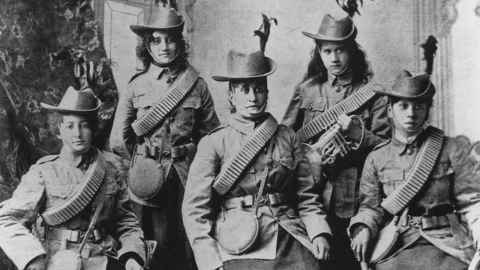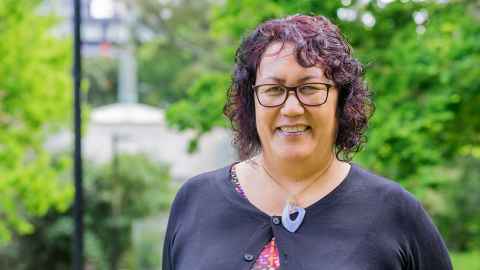Māori mobilising in a crisis: a proud history
11 May 2020
Opinion: In recent weeks, Aroha Harris has been pondering the iwi Māori capacity to mobilise, noticing how quickly and efficiently Māori groups and communities throughout the country rallied in response to the Covid-19 rāhui.

Remote communities set up check points to regulate the movement of people into and through their territories. Māori clergy turned Facebook into a pulpit for morning and evening karakia and Sunday services. Te Pihopatanga o Aotearoa is just one example. Te Rōpū Whakakaupapa Urutā has been both advising Māori about Covid-19 and making a stand for government responses that centre equity, keep faith with mana motuhake, and aim for an exit from the current rāhui that allows Māori to thrive.
For me, social media has been a steady stream of acknowledgement of iwi, urban Māori, kura, and Māori organisations of all shapes and sizes making and delivering care packages, kai hampers, sanitiser and masks. Through all this activity, I see a robust and grounded home front that reflects important elements of our past.
Historically, major crises – whether war or disease – that took and disrupted far too many lives also generated unreservedly Māori responses, often focusing on whānau and community health and wellbeing.
An example was the Ngāpuhi Sisters of Mercy, from prominent families of the Whangarei District who trained in first aid, intending to qualify as nurses in the field. They appear to have attended public events and provided first aid services, like at the 1901 Marsden military sports day.
They also fundraised for New Zealand’s contributions to the South African War. Throughout the same period, and well into the 1910s, Māori communities continued to suffer disproportionately from typhoid, smallpox, tuberculosis and other infectious diseases.

The Young Māori Party advocated for a comprehensive Māori health programme, including substantial nurse training, leading to an autonomous network of Māori nurses working in Māori districts.
Despite decades of lobbying, planning, and work, those aspirations were dashed for a range of reasons that included a lack of government support and Pākehā resistance. In the meantime, nurses Akenehi Hei (Te Whakatohea and Te Whānau a Apanui) and Heni Whangapirita (Ngāti Porou) were among the Māori women who trained and qualified under the Māori nursing programme.
Akenehi’s several nursing appointments included working at Te Kao during a typhoid outbreak in 1909. In the winter of 1910, she returned to Gisborne to nurse a niece who was sick with typhoid, as well as other family members. She succumbed to the disease herself later that year, dedicated to her nursing mission to the end.
During World War I, efforts on the home front included the Māori Soldiers’ Fund, launched in 1915. The fund was an initiative of Miria Pomare (Rongowhakaata and Te Aitanga-a-Māhaki) and Lady Annette Liverpool, the wives of Maui Pomare and the governor (later governor-general) Lord Liverpool respectively. The fund's activities included sending kai and clothing to the Māori contingent, holding receptions for returned servicemen, and visiting wounded soldiers in hospital.
Another prominent woman, Te Puea Hērangi, mobilised Māori, specifically Waikato-Tainui, against the same war. She stood shoulder-to-shoulder with Waikato men when they refused conscription and were roundly punished as a result.
And her leadership and service continued when her home community of Mangatāwhiri was devastated by influenza in 1918. She saw to it that 100 orphaned children were placed with remaining families and embarked on a project that led eventually to the establishment of Tūrangawaewae at Ngāruawāhia as the Kīngitanga centre.
Māori are well-equipped for mobilisation; we’re called to instant action every time an unexpected hui is on its way to the marae.
Whānau health and welfare remained on the agenda of Māori women’s organisation through the rest of the century. Established at Ōhinemutu during the inter-war years, the Women’s Health League, with its mostly Māori membership, focused on the health of women and children in the home.
When the 28th (Māori) Battalion formed in 1940, young Māori men quickly filled its companies, though some opposition continued, including in Waikato. Back home, Māori throughout the country applied their energies to supporting ‘the boys’.
Marae, youth groups, and tribal committees fundraised by holding dances, picture shows, and basket socials. Māori musicians and performers, like Ana Hato, Deane Waretini, and Epi Shalfoon, organised concerts, visited hospitals, and performed for servicemen.
New wartime music included Anania Amohau’s ‘Māori Battalion March to Victory’, Tuini Ngawai’s ‘Arohaina Mai’, and Ruru Karaitiana’s ‘Blue Smoke’. Alongside the care packages and Christmas parcels, many Māori communities also turned their attention internally to their own welfare, and that of their homes and marae, in the process laying the foundations for community work that would follow in the second half of the century.
All that mobilisation. All that energy and action. All that rallying in times of hardship and crisis. In the past and in the present. I feel immensely proud. But I’m also a bit sad and wary because our mobilisations have so often been met with resistance, demands to prove their value and relevance, and even charges of separatism; and because they have so often turned on the defence of Māori lives and lifeways. In the past and in the present.
However, to risk generalising, Māori are well-equipped for mobilisation; we’re called to instant action every time an unexpected hui is on its way to the marae.
Whanaungatanga, or relatedness, means our lives are undergirded by organisation and networking, a foundation for belonging, which is a great boost in times of need, such as those we find ourselves in today.
Aroha Harris (Te Rarawa, Ngāpuhi) is an Associate Professor in history at the University of Auckland, and a member of the Waitangi Tribunal.
This article reflects the opinion of the author and not necessarily the views of the University of Auckland.
A version of this article appeared in Auckland Museum’s Online Cenotaph to commemorate Anzac Day and in The Spinoff, Maori Mobilisation in a crisis: a proud history, 7 May, 2020.
Media contact
Julianne Evans | Media adviser
Mob: 027 5625868
Email: julianne.evans@auckland.ac.nz